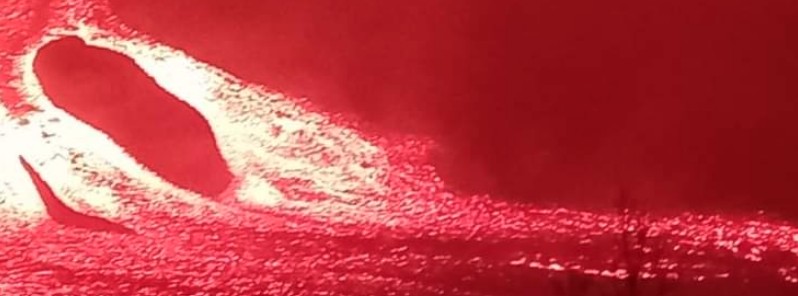Renewed activity, new lava flow at Pacaya volcano threatens nearby communities, Guatemala

The activity at Guatemalan Pacaya volcano switched from explosive to predominantly effusive on April 29, 2021, with two active lava flows — one on the Southeast flank and the other on the Northwest. The new phase of increased activity comes less than a week after authorities declared the last eruptive phase over (February 5 – April 23).
Seismic monitoring parameters indicated a shift from explosive activity to predominantly effusive on April 29, leading to the generation of a new lava flow on Pacaya's northern flank.
Officials said they can't rule out that high explosive episodes resume in the coming hours or days.
The Southeast lava flow had a total length of 1 600 m (5 250 feet) on April 29 and was at a distance of 100 m (330 feet) from the area known as La Breana.
It had several branches that released incandescent material on its fronts, accompanied by magmatic gases in its path.
#VolcánDePacaya. El volcán de Pacaya presenta una nueva fisura en el flanco Norte, dicha fisura expulsa material incandescente y genera dos flujos de lava de 200 metros de largo. pic.twitter.com/UapmZlWeqJ
— CONRED (@ConredGuatemala) April 29, 2021
April 29, 2021, ~ New Fissure/Lava Flow ~ Volcan De Pacaya, Guatemala #pacaya #volcano #guatemala
It seems that a new eruptive fissure vent opened on the W-NW flank, as reported by the volcano observatory INSIMUVEH. pic.twitter.com/2uHGc7jKgf— Volcano Time-Lapse (@DavidHe11952876) April 30, 2021
ACTUALIZACIÓN ACTIVIDAD VOLCÁN PACAYA
29 de abril 2021INSIVUMEH Prevención para una Mejor Nación#SomosINSIVUMEH #Guatemala #ElCivNoSeDetienehttps://t.co/G11KcZk4iW
— INSIVUMEH Guatemala (@insivumehgt) April 29, 2021
VIDEO: Lava gushes from Guatemala's Pacaya volcano near the capital.
The current eruption of Pacaya is causing lava to pour to the surface, as opposed to an explosive burst with violent expulsions of smoke and ash pic.twitter.com/3F04tIblur
— AFP News Agency (@AFP) April 30, 2021
Vecinos de San Vicente Pacaya me hacen llegar este video.
A esta hora se reporta gran flujo de magma desde un nuevo crácter que se formó esta madrugada en el volcán de #Pacaya.
El volcán de Pacaya no se ha calmado… pic.twitter.com/CuOvnSHn6M
— El_PrincipitoGt (@El_principitoGT) April 30, 2021
Una noche complicada viven los habitantes de la ladera norte del volcán #Pacaya, #Guatemala, cuando la madrugada de ayer una nueva fisura generó un nuevo río de lava que avanza rápidamente.
Foto: Municipalidad San Vicente Pacaya. pic.twitter.com/EVDGhElMFg
— Alejandro S. Méndez (@asalmendez) April 30, 2021
Active lava flows are expected to continue advancing and it is not ruled out that more flows will be generated on other flanks of the volcano, INSIVUMEH said, recommending CONRED to activate the lava flow threat mitigation protocols, which they consider necessary.
Access to the Mackenney crater and areas recently affected by the lava flows is prohibited.
"This area is considered quite unstable due to high temperatures and outgassing which could cause burns or other serious injuries," INSIVUMEH said. "Do not go near the fronts of active lava flows as they give off incandescent blocks and magmatic gases."

Geological summary
Eruptions from Pacaya, one of Guatemala's most active volcanoes, are frequently visible from Guatemala City, the nation's capital.
This complex basaltic volcano was constructed just outside the southern topographic rim of the 14 x 16 km (8.7 x 9.9 miles) Pleistocene Amatitlán caldera. A cluster of dacitic lava domes occupies the southern caldera floor.
The post-caldera Pacaya massif includes the ancestral Pacaya Viejo and Cerro Grande stratovolcanoes and the currently active Mackenney stratovolcano.
The collapse of Pacaya Viejo between 600 and 1 500 years ago produced a debris-avalanche deposit that extends 25 km (15 miles) onto the Pacific coastal plain and left an arcuate somma rim inside which the modern Pacaya volcano (Mackenney cone) grew.
A subsidiary crater, Cerro Chino, was constructed on the NW somma rim and was last active in the 19th century.
During the past several decades, activity has consisted of frequent strombolian eruptions with intermittent lava flow extrusion that has partially filled in the caldera moat and armored the flanks of Mackenney cone, punctuated by occasional larger explosive eruptions that partially destroy the summit of the growing young stratovolcano. (GVP)
Featured image credit: Municipalidad San Vicente Pacaya

Commenting rules and guidelines
We value the thoughts and opinions of our readers and welcome healthy discussions on our website. In order to maintain a respectful and positive community, we ask that all commenters follow these rules.